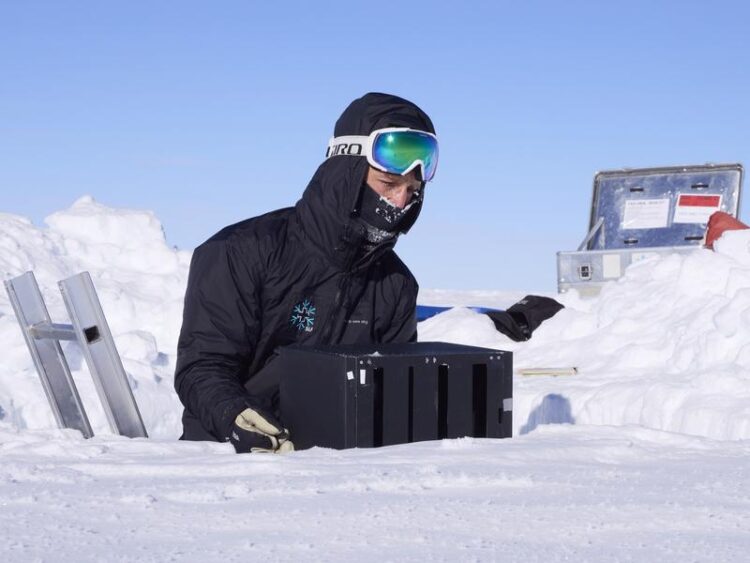The snow has to be CT scanned

Matthias Jaggi measures a snow profile near the DomeC research station in Antarctica.
Foto: Matthias Jaggi, SLF - CC-BY
Having returned from Antarctica, SLF technician Matthias Jaggi talks about new insights into snowpack structure, future work to refine climate models using the samples collected, a personal career highlight – and traffic.
Mr Jaggi, what were the main insights you gained during your weeks in Antarctica?
It reminded me just how inhomogeneous the snowpack is. The wind has an immense influence on its structure, piling up dunes and creating sloping layers. These aren’t just arranged horizontally, layer upon layer. I’m curious to see whether and how that will make it harder to interpret our experiments.
In what way?
The idea was to cut out four identical blocks of snow, i.e. with the same or similar layering, from the snowpack and to investigate the snow metamorphism in each block at different temperatures. Now there aren’t just four different temperatures but also four different layerings and microstructures within the blocks. We have to take this into account when interpreting the results. However, I’m assuming that we’ll still be able to use the results. They are particularly important for climate researchers. Until now, their models haven’t factored in the physical process of interaction between snow metamorphism and the stable oxygen isotopes (see box) in the water molecules. To understand the signal of these isotopes in the ice, we need to understand all the physical processes, from evaporation over the oceans, cloud formation in the atmosphere, precipitation, snow accumulation, snow metamorphism and eventual compaction via firn to ice.
What do climate researchers actually do with the ice?
The deepest ice in Antarctica is 1.5 million years old. The researchers are drilling right down into it and bringing ice cores to the surface as samples. Among other things, these cores contain water isotopes which the researchers use as climate indicators. That’s possible because these isotopes are present in the ice in different ratios depending on the prevailing temperatures in the past. Based on these, the scientists can therefore reconstruct the temperature at a particular period in the past using model calculations. Our results should help them make this climate reconstruction more precise.
So the work isn’t finished now that you’re back from Antarctica?
Far from it. Some of our samples are currently on their way from Antarctica to France to be analysed there. Others are due to arrive in Davos in June. I still have a lot of hard work ahead, as the Antarctic snow has to be CT scanned. That will probably keep me busy until the end of the year. And then there’s the paper to write…
You mean the scientific summary of the methods and results?
Exactly. The goal is to publish my first scientific paper, with a lot of help from my colleagues. That isn’t something technical staff normally do, but if I could complete this challenge it would obviously be a personal highlight in my career.
Would you have liked to stay for longer?
I’m happy to be back. It’s good to be able to decide for myself how to spend my free time again, to have more options and greater freedom of movement. I missed that and I’m making the most of it again now.
Has there been anything you’ve had to readjust to here?
Definitely: all the people, the traffic and being expected to multitask at work. There’s virtually no artificial noise in Antarctica. It’s so much quieter and less hectic. And being able to mentally focus on one project and task for two months I found extremely invigorating. I definitely need to get used to multitasking again.
What are… isotopes?
Isotopes are atoms of the same element with different masses. They differ in the number of neutrons in the nucleus. Chemically speaking, isotopes of an element generally behave in the same, or at least a similar, way. However, their physical properties differ. For example, less than 10% of the more than 3,000 isotopes are stable. The rest decay radioactively.
Weitere Informationen:
https://www.slf.ch/en/news/packing-for-christmas/ The preparations: Packing for Christmas
https://www.slf.ch/en/news/antarctica-blog-part-1/ Antarctica Blog Part 1: the arrival
https://www.slf.ch/en/news/antarctica-blog-part-2/ Antarctica Blog Part 2: free at last!
https://www.slf.ch/en/news/antarctica-blog-part-3/ Antarctic Blog Part 3: daily and penal labour
https://www.slf.ch/en/news/antarctica-blog-part-4/ Antarctic Blog Part 4: the final spurt
Media Contact
All latest news from the category: Earth Sciences
Earth Sciences (also referred to as Geosciences), which deals with basic issues surrounding our planet, plays a vital role in the area of energy and raw materials supply.
Earth Sciences comprises subjects such as geology, geography, geological informatics, paleontology, mineralogy, petrography, crystallography, geophysics, geodesy, glaciology, cartography, photogrammetry, meteorology and seismology, early-warning systems, earthquake research and polar research.
Newest articles

A blueprint for mapping melting ice sheets
Researchers in the Stanford Radio Glaciology lab use radio waves to understand rapidly changing ice sheets and their contributions to global sea-level rise. This technique has revealed groundwater beneath Greenland,…

Water hyacinth plant pots – utilization of an invasive species
Together with Fiber Engineering GmbH, the DITF presents a process for the production of biodegradable plant pots. The products are cost effective and competitive. At the same time, the production…

Current research on the new 6G mobile communications standard
Nursing care robots, autonomous driving, digital twins: all of these high-tech applications will play an essential role for the new 6G mobile communications standard. The first commercial 6G networks are…



